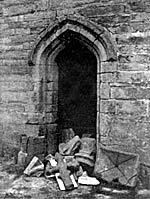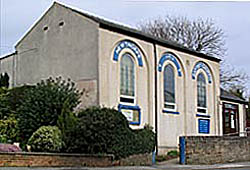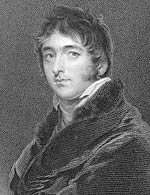The rector poached

Doorway at Beauvale Priory.
Apart from its monastic associations and the exploitation of its coal, the village had a history of its own A doctor (leech) is mentioned in 1294 and in 1316 Newthorpe was accounted fiscally as half a vill and the Earl of Lancaster and the prior of Lenton were its lords.
Next year, the rector of Nuthall and a Newthorpe man were accused of hunting deer in Codnor Park, and in the reign of Edward II, Ralph de Newthorpe represented Nottingham in Parliament.
About that time Ralph Annesley recovered possession of a messuage, 20a. of land and two parts of a mill against Peter de Creasy and others and was awarded damages to the large amount of 20 marks. In a deed of the 13th century, mention is made of "le Croshalveacres," but whether this was a structure or merely a boundary name is uncertain. It was at "le Neufeld," abutting "upon a pasture called Begerleth," and may conceivably have been an erection of stone in the form of a cross to indicate a limit of Lenton Priory land, but this can be advanced only as a conjecture.
Executed priors
About the end of the 15th century, the prior of Beauvale exchanged lands about Annesley with Thomas Samon for "lands, woods, coal," &c., here and at Underwood, Selston and neighbouring parts; but before this venture could be developed to any extent the priory was suppressed.
Its prior was hanged with revolting cruelty for refusing to acknowledge Henry VIII, as supreme head of the Church in England and the priory with its possessions passed to lay owners. In 1500 John Strelley bequeathed his lands in Newthorpe and Kimberley to Rd. Baker, "his old servant," for his life with reversion to his own right heirs.
According to the Valor of 1534, Lenton Priory was then receiving a gross rental of £7 2s. 4d. from Newthorpe and paying its bailiff here and at Watnall 13s. 4d. a year. Four years later that priory was dissolved by attainder and Prior Heath came to the gallows under circumstances akin to pose which marked the death of Prior Lawrence of Beauvale.
The Dissolution
The Monastic Dissolution saw Lenton's share of Newthorpe pass with Felley Priory and what it had here, to a couple of speculators who lost little time in selling them to William Bolles. Beauvale's part with that priory and much of its possessions, including seven messuages, 20 cottages, a water-mill 200a. of meadow 150 of pasture and; rents amounting, to 14s. 7d. here and at Underwood, passed to Sir Wm. Hussey of London, and something has; already been said of the quarrel between these new owners.
Upon the death of Sir Wm Hussey his properties descended by the marriage of his two daughters to the families of Disney and Columbell each of which owned large estates in the shire. Later a process of subdivision set in and small holdings became more numerous but the bulk of the oil remained as two ownerships and continued so until our time. On Saxton's map of Nottinghamshire, dated 1576. Giltbrook figures as "gylt brigg alias Kylte brigge," crossing a brook. This was the first map of the shire, but as Kylte brigge the bridge had appeared in records of about 1500.
Of Newthorpe in the earlier part of the 17th century, little is known, but in the Civil War, Col. Charles White of this village played a conspicuous part. Mrs. Hutchinson described him as "of mean birth and low fortune, ambitious, vainglorious, hypocritical and treacherous" being a few of the opprobious terms she applied to him after he had committed the unpardonable fault of disagreeing with her husband.
Following upon the death of Cromwell, he had supported the royalist rising in 1659 but his attack upon Derby failed, and being captured, he suffered imprisonment until the eve of the Restoration when he was freed.
Troubles over faith

Newthorpe Methodist Chapel was established in 1828 (photo: A Nicholson, 2004).
The inhabitants of Newthorpe parished at Greasley; within its church they were christened, married and buried, and in 1653, when the puritan Robert Smalley was inducted to the living, they found the Church of England liturgy replaced by a Presbyterian form of service.
In 1662 he was ejected from the vicarage for refusing to conform and, setting up as a nonconformist minister at Moorgreen, he gathered round him a congregation here. Under the Indulgence which Charles II ventured to concede to dissenters in 1672, the houses of John Leighton (who had been ejected from Linby rectory), Robt. Wheatley and the tanner, George Lane, all in Newthorpe, were licensed for Presbyterian worship and here Mr. Smalley preached to congregations from the neighbourhood, but within one year the Indulgence was withdrawn and such services became illegal.
ROBERT SMALLEY described as "a hard student and a winning preacher," who subsequently retired to Mansfield where open nonconformity lingered, and it is related that at one of the meetings at this 'little Zoar' he experienced a presentiment of death. After closing the service he fell down and expired.
'Guiltbridge Lane' is shown upon a map of 1684 and about this time the condition of the highways around the village was so bad that the parish authorities had to be indicted to procure their amendment.
Some 20 years later, the Justices sanctioned the application of Sir Charles Sedley for permission to enclose a footway from Eastwood to Newthorpe via Nuthall, but no provision was made for a compensatory public way.
Keeping little ones out
A pathetic sidelight on the state of the poor in the reign of Anne is afforded by another order of the Justices directing the churchwardens and overseers of the parish of Greasley to pay 12d. a week for the maintenance of Francis Cow of Newthorpe, "a poor prisoner in the county gaol" at Nottingham.
Newthorpe was one of the villages which benefited from the bequest of the Ilkeston almshouse founder, Richard Smedley, who in 1744 left a rent-charge of £5 a year for the education of poor children of the village and a similar sum for one needy inhabitant to be maintained in his almshouse.
His will stipulated that no child should be taught at the charge of his fund before having " learned the battledore," this provision doubtless being made to prevent children from attending at such a tender age as to be incapable of learning to read.
The school building was closed in 1876 and its income applied towards the payment of fees for boys and girls of the village at elementary schools.
It is supposed that enclosures had been made here soon after the suppression of the monasteries, but the general enclosure took place in 1776 when the district began to assume its modern appearance.
Colliers didn't like him
In the national outbreak of patriotism that greeted the designs of the French revolutionists upon England in 1787 Nottinghamshire took an active part and sympathisers with the hated foreigners had an unhappy time. Supporters of the renegade Tom Paine, in particular, fared ill and three of them belonging to Sutton were convicted at the Assizes for denouncing King George and the Government, and exalting the teachings of the "Rights of Man."
In an outburst of too exuberant loyalty, the colliers rose in wrath and making a straw effigy of its author (who by then had fled to Paris and become a member of the Convention) they hung it upon gallows and shot at it till sunset.
When their powder was spent, they went to the village shop for more but were denied, as it was illegal to sell gunpowder after the sun had set lest firm, should he occasioned by its use. They broke the shop windows and otherwise damaged the property, and when the victim of these outrages bought legal redress in the courts at Nottingham, he was seized by a mob, who deemed him a supporter of Paine, and dragged in torn clothes to the pump in front of the Exchange and soused until his tormentors were tired.
To make him appear more disreputable his coat skirts were cut off, it is said at the suggestion of a man named Spencer, and inch abbreviated garments subsequently came into common use and became known as 'spencers'
Drink spoilt them
By this time collieries were developing and a pit had been sunk at Beggarlee. The opening of the Nottingham Canal in 1792 no doubt increased production but. contrary to expectation, the price of coal rose, instead of falling, in consequence of the ever increasing demand pits were yet mostly primitive and crudely worked, men being lowered by chains strapped round their thighs, coat being rawed, by horse-powered windlasses. The average selling price around this district was 10s. a ton and wages rarely exceeded 8s, or 9s. a week. The homes of the colliers were often restricted to a couple of rooms, and as mining was thirsty work, the village was well supplied with inns. A traveller through the Erewash district in 1782 described the miners as coarse and profane, but good-hearted save when intoxicated.
On the eve of the 19th century, Throsby described Newthorpe as "a large hamlet which parishes to Greasley." A generation late, it was noted as being "a hamlet and constablewick which includes the small village of its own name and the scattered dwellings of Baggalee and Hill Top, about one mile west of Greasley Church."

William Lamb, Viscount Melbourne (1779-1848).
Viscount Melbourne — Queen Victoria's first prime minister and her friend—a great land-owner hereabouts, who occasionally resided at his neighbouring mansion, Lamb Close, owned the larger part of Newthorpe, and the Earl of Stamford and Warrington, who had a minor portion, was paying the Smedley charity £5 yearly for a mistress to teach 12 children to read.
The poor were receiving doles of money on Christmas Day and bread at Candlemas out of the Mansell charity of 1797-98 which applied also to the whole of the mother parish of Greasley, and by the middle of the century, the village population was estimated to be about 1,150.
Later days
In 1885, Newthorpe was said to be a large and increasing hamlet, including the still scattered districts of Hill Top, Lynn Croft, Beggarlee, Giltbrook and the Commons, with well-established collieries at Beggarlee and Hill Top. Lord Melbourne's lands had passed by descent to Earl Cowper, but the estate was being broken up into small holdings. Since then, this process has continued, and a new colliery area has been created in the area of New London which extends into the parish of Kimberley.
